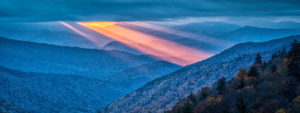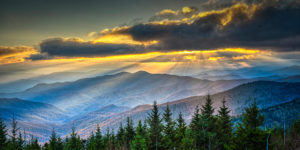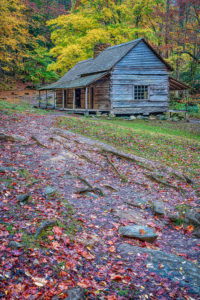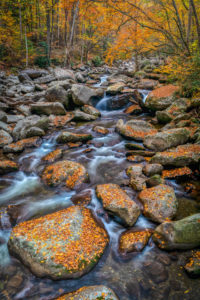This week I’ll be spending a few days in the Smokies, so I revisited this column I wrote for the Gazette in Colorado Springs 26 years ago. Hope you enjoy your visit too!
 Growing up in East Tennessee, my definition of mountains began and ended with the Appalachians, specifically Great Smoky Mountain National Park.
Growing up in East Tennessee, my definition of mountains began and ended with the Appalachians, specifically Great Smoky Mountain National Park.
Whenever I travel back in that direction I always watch for the rounded green summits veiled in blue haze from the window of the airplane. When I see the mountains, I know I’ll soon be home.
As a Girl Scout on a day hike or a young woman on a backpacking adventure, those peaks always seemed plenty high to me, so I was a bit shocked when my Colorado husband said, “you mean the smoky hills” when I spoke to him of my native mountains.
It’s true the Smokies will never “measure up” to the Rockies. Although the national park encompasses the highest portion of the Appalachian range, Clingmans Dome is the highest of the 16 peaks over 6,000 feet, and it only measures 6,642. There are no fourteeners in the Smokies.
The Cherokee Indians named the mountain range that was their home Great Smoky because of the haze that continuously nestles in the valleys and glistens in the morning sunrise. The mist comes from the dense vegetation, and the park still boasts 150 species of trees and over 2,000 species of plant life, including the white-blossomed rhododendron, pink azalea, and myriad of ferns and wildflowers that I remember lining the moist mountain paths.
It’s impossible for me to think back to hiking the trails of the Smokies without remembering the cool smell of green, or my delight at discovering a “jack in the pulpit” nestled amongst the wildflowers.
 Most summer, Sunday afternoons when I was little my family drove to the mountains to cool off. We stopped for a big lunch at the Apple Tree Inn in Pigeon Forge, a sleepy little town before Dolly Parton built Dollywood and all the other tourist attractions sprang up. Then we’d roll down the windows in the station wagon and take the windy road through Gatlinburg and all the way to the top of Clingmans Dome. My dad would drop a quarter in the long-range binoculars and my sisters and I would take turns standing on “tippytoe” to see all the way to Virginia.
Most summer, Sunday afternoons when I was little my family drove to the mountains to cool off. We stopped for a big lunch at the Apple Tree Inn in Pigeon Forge, a sleepy little town before Dolly Parton built Dollywood and all the other tourist attractions sprang up. Then we’d roll down the windows in the station wagon and take the windy road through Gatlinburg and all the way to the top of Clingmans Dome. My dad would drop a quarter in the long-range binoculars and my sisters and I would take turns standing on “tippytoe” to see all the way to Virginia.
A few descendants of old mountain families still live in pockets within the park, having managed to get lifetime leases from the park service when the land was claimed by the government in 1934. But most of the residents then and now are the white-tailed deer, raccoons, foxes, and black bears that call the Smokies home.
Before tourists were discouraged from interacting with wildlife, we used to get out of the car whenever we saw a bear and run to toss it stale Ritz crackers or take its photo. At school each Monday there would be a competition as to who had seen the most bears the day before. Twenty-one is a record I remember claiming.
Only in the Smokies can you rock on the front porch of a rustic cabin and listen to the Roaring Fork river dance around the boulders as you “soak in” the mountains. While I may marvel at the Rockies, I can’t say that I ever remember “soaking them in” as I always have the Smokies.
Gentle, green, smoky hills, you aren’t tall, but you are beautiful to behold.
All photos courtesy of Steve Hixon, www.stevehixonphotography.com.
